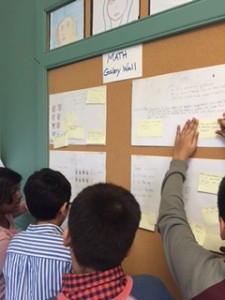This year, I tried something brand new with one of my music classes. We wrote lyrics to a song, sent them off to a song writer and performed the original song called “Gymnastics” at our spring concert! This is how we did it.
The idea came earlier this year when I was trying to come up with ideas for our spring concert. I usually ask each class in January what they would like to do for the concert and then they create something to share. This year, our concert had lots of creations, including a tableau piece about anti-bullying, a Japanese fan dance with ORFF instruments, some black light performances and the original “Gymnastics” song.
The grade 3 class that wanted to do the original song was interested in working with a song writer. (I probably could have written a song, but it was WAY more exciting sending the lyrics off). Our first step was to decide what the song was going to be about.
I handed out a blank piece of paper to groups of three and told them to brainstorm some ideas for the topic of the song. After they brainstormed, I asked them to narrow it down to three ideas that they were really interested in. As a class, we did a community circle, and shared our favourite ideas. I noticed that the topic of sports came up in every group and highlighted that for the students. I asked the students to think of a sport that could show off the talents of their class. Immediately, gymnastics came up and the song was on its way! (This class is full of twisty, fidgety, wiggly students. Gymnastics couldn’t have been more perfect.)
Their classroom teacher took over the next part of the activity by letting the students do an inquiry-based assignment about gymnastics. They watched videos about, read, and studied the sport of gymnastics. By the time they came back to me, they were a fountain of knowledge about gymnastics. Our next step was to come up with ideas that we wanted to have in the song. We then compiled all of our ideas into a list and got them ready to send off to our songwriter.
We chose our song writer from the website www.fiverr.com .
www.fiverr.com is a website where you can hire people to do a wide variety of services for five dollars. There is a large section on the website for songs. You can have rap songs written, ukulele songs, etc…. I chatted with the song writer we chose and gave these simple instructions:
- The lyrics can go in any order
- Write the song in either C major, D major, F major or G major
- Please don’t make the melody have large jumps between notes
- The range of the melody should be from about middle C to D (one octave plus a note)
- Make it upbeat and fun!
The song came back and it was amazing. It was a big hit at our spring concert and I am sure the kids will always remember the gymnastic song that they wrote.





